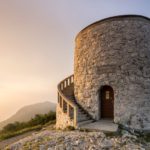Fortica, a fortress in Otočac, is a true rarity because it is one of the only two remaining regular triangular forts in Croatia, while there are only several of them in Europe. Fifteen Stations of the Way of the Cross, placed on Fortica’s slope, are a contribution not only to the religious content in this town but also represent a distinctive artistic experience for every visitor.
The sculptural Calvary of Otočac begins at the foot of Fortica with the Most Holy Trinity piece. It continues with fifteen stone steles which are placed from the foot of Fortica to the Chapel of Our Lady of Sorrows, located almost at the top of the hill, enriching the existing view of the area and returning an already somewhat forgotten memory of the Calvary, the other name of the hill used by the Christian faithful.
The fortress Fortica was built by people of Senj with the local population in 1619, fortifying the town of Otočac on the eponymous hill, located on an island in the middle of the river Gacka, but also Senj which was defending itself in the Gacka region from Ottoman incursions.
It was a fortress with three towers, the biggest on the east side and two smaller ones on the west side, interconnected by walls with a thickness of 1.80 – 2 m. It was built in haste with smaller stones, evidently, there was no time or money to carve stone blocks. The inside courtyard was very narrow and included tanks that were used to collect water. Fortica was used as a permanent residence for soldiers, storage for ammunition and gunpowder and as a storage for food with kitchens and dormitories.
Archaeological research discovered the walls of each of these towers and interconnecting walls, but it also discovered the entrance door threshold. Fortica’s entrance was on the south side, towards Otočac. The entrance door was high above the ground, so in the time of its construction, Fortica could only be entered by using a ladder, while later, a porch with stairs was built. During its military use, the Fortica hill was stark for defense purposes, with no trees. Fortica’s first commander was Andrija Kolaković. Fortica was abandoned in the second half of the 19th century when Otočac started to systematically develop as an urban environment. All important military buildings of the Otočac regiment were located beneath Fortica. The fortress began to lose its significance at the start of the 19th century, as can be seen from the fact that it was adapted into a gunpowder magazine in 1804. In 1882, a strong wind raised the roof of the widest tower and dropped it on the ground, so not only did neglect but also the weather contributed to Fortica’s deterioration.
At the start of the 20 century, Fortica was being afforested. Pharmacist Častek ordered Czech pine trees to be planted on the hill’s private property.
The new forest was growing nicely until World War II. In 1941, the Italians that came to Otočac ordered the trees to be cut and placed their battery there. An interesting fact to mention is that the fortress Fortica, in its restored and preserved state, is now the only renaissance remnant in the Otočac area. In fact, before the Renaissance, rectangular forts were built and the triangular ones were much rarer, while in the Renaissance, the forts and castles were fortified with round towers.
Author: www.tz-otocac.hr




